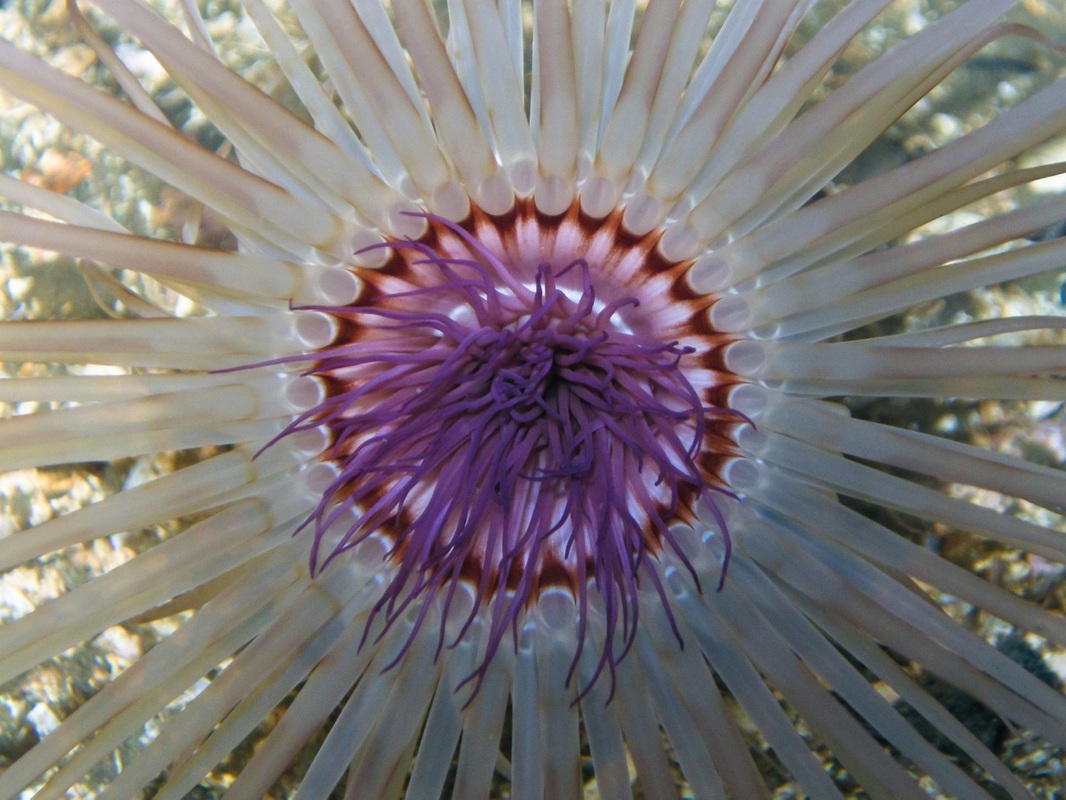Tube-dwelling anemone, tube anemone • Pachycerianthus fimbriatus

The tube-dwelling anemone's two sets of tentacles are visible at this angle looking straight down. Photo by Mike Munroe
Identification
The tube-dwelling anemone has an outer set of of long, delicate tentacles encircling a shorter inner set that hides the mouth. Tentacles vary in colour from light to purplish-black, and may be banded. The rest of the anemone is hidden from view, in a mostly buried black leathery tube made from material secreted by the anemone. The tube can be up to a meter in length and 2.5 cm in diameter; the animal gets to 35 cm long with a tentacle diameter of 20 cm.
Habitat & Range
The tube-dwelling anemone can be found in soft, level substrates in the subtidal (to 30 m deep) and occasionally the intertidal. Individuals may form extensive flower-like fields. Its range extends from southern Alaska to southern California.
Intriguing
This anemone is preyed up on by the giant nudibranch (Dendronotus iris) ; the nudibranch may also attach its egg masses to the anemone's tube. The anemone is capable of retracting into the its when disturbed or under attack.
The tube-dwelling anemone has an outer set of of long, delicate tentacles encircling a shorter inner set that hides the mouth. Tentacles vary in colour from light to purplish-black, and may be banded. The rest of the anemone is hidden from view, in a mostly buried black leathery tube made from material secreted by the anemone. The tube can be up to a meter in length and 2.5 cm in diameter; the animal gets to 35 cm long with a tentacle diameter of 20 cm.
Habitat & Range
The tube-dwelling anemone can be found in soft, level substrates in the subtidal (to 30 m deep) and occasionally the intertidal. Individuals may form extensive flower-like fields. Its range extends from southern Alaska to southern California.
Intriguing
This anemone is preyed up on by the giant nudibranch (Dendronotus iris) ; the nudibranch may also attach its egg masses to the anemone's tube. The anemone is capable of retracting into the its when disturbed or under attack.
References
Adams, M.J. (2008). Pachycerianthus fimbriatus (Tube dwelling anemone). Beach Watchers. Washington State University. Accessed 09/12/2014.
Cowles, D. (2008). Pachycerianthus fimbriatus McMurrich, 1910. Invertebrates of the Salish Sea. Rosario Beach Marine Laboratory. Accessed 09/12/2014.
Harbo, R. M. (1999). Whelks to whales: Coastal marine life of the Pacific Northwest. Madeira Park, BC: Harbour Publishing. P. 65.
Lamb, A., and Hanby, B. (2005). Marine Life of the Pacific Northwest [electronic version]. Madeira Park, BC: Harbour Publishing.
Tube anemone. Monterey Bay Aquarium. Monterey Bay Aquarium Foundation. Accessed 09/12/2014.
Authors and editors of page
Kelly Fretwell and Brian Starzomski (2014).
Adams, M.J. (2008). Pachycerianthus fimbriatus (Tube dwelling anemone). Beach Watchers. Washington State University. Accessed 09/12/2014.
Cowles, D. (2008). Pachycerianthus fimbriatus McMurrich, 1910. Invertebrates of the Salish Sea. Rosario Beach Marine Laboratory. Accessed 09/12/2014.
Harbo, R. M. (1999). Whelks to whales: Coastal marine life of the Pacific Northwest. Madeira Park, BC: Harbour Publishing. P. 65.
Lamb, A., and Hanby, B. (2005). Marine Life of the Pacific Northwest [electronic version]. Madeira Park, BC: Harbour Publishing.
Tube anemone. Monterey Bay Aquarium. Monterey Bay Aquarium Foundation. Accessed 09/12/2014.
Authors and editors of page
Kelly Fretwell and Brian Starzomski (2014).



